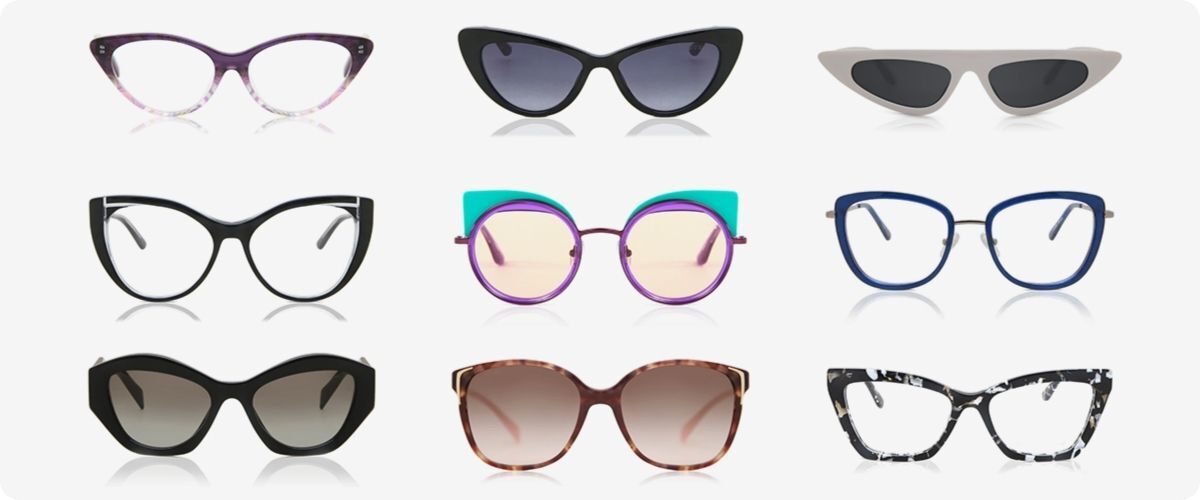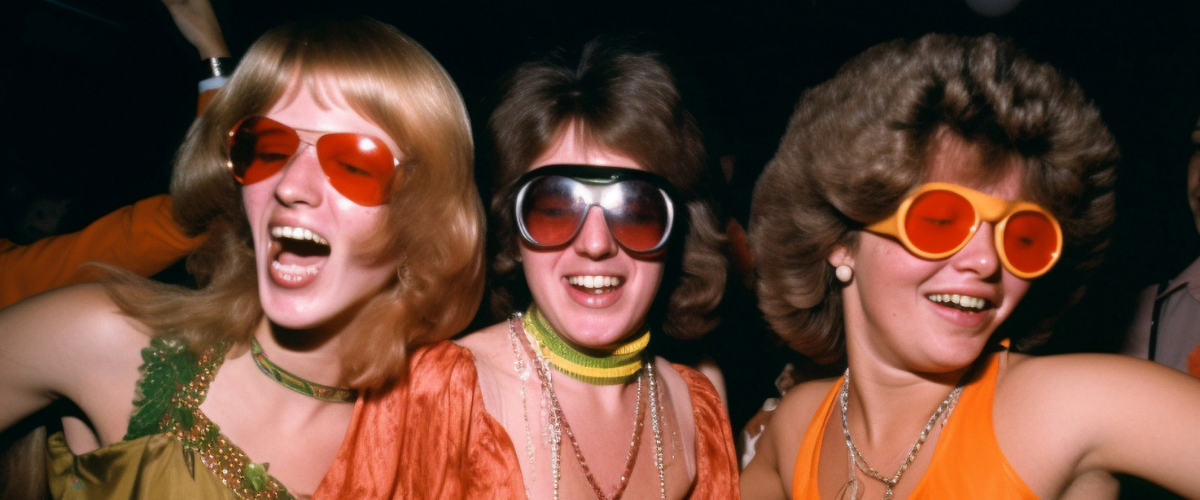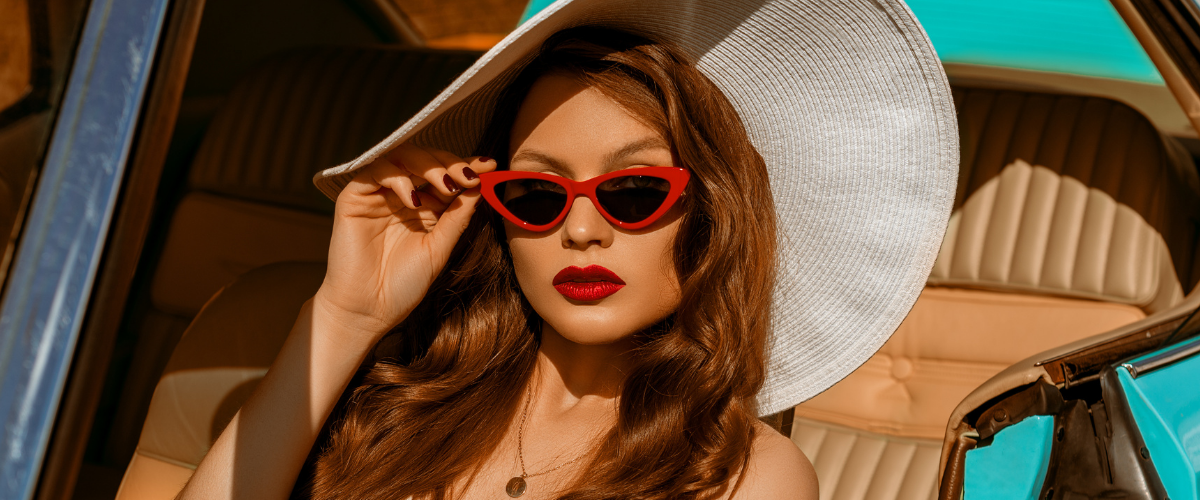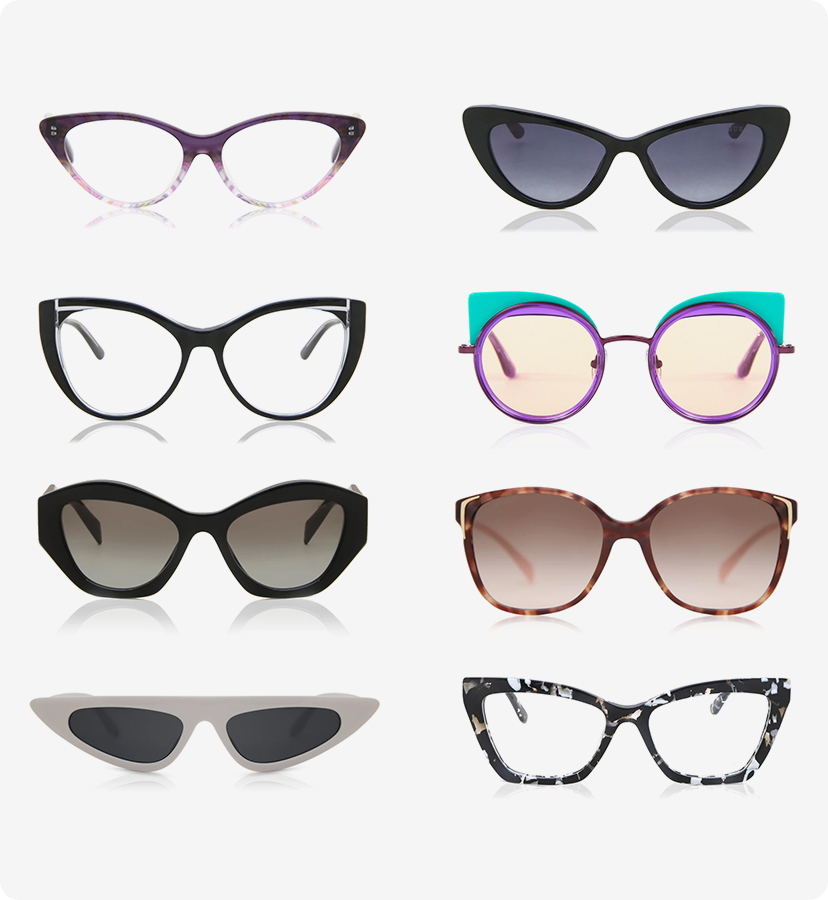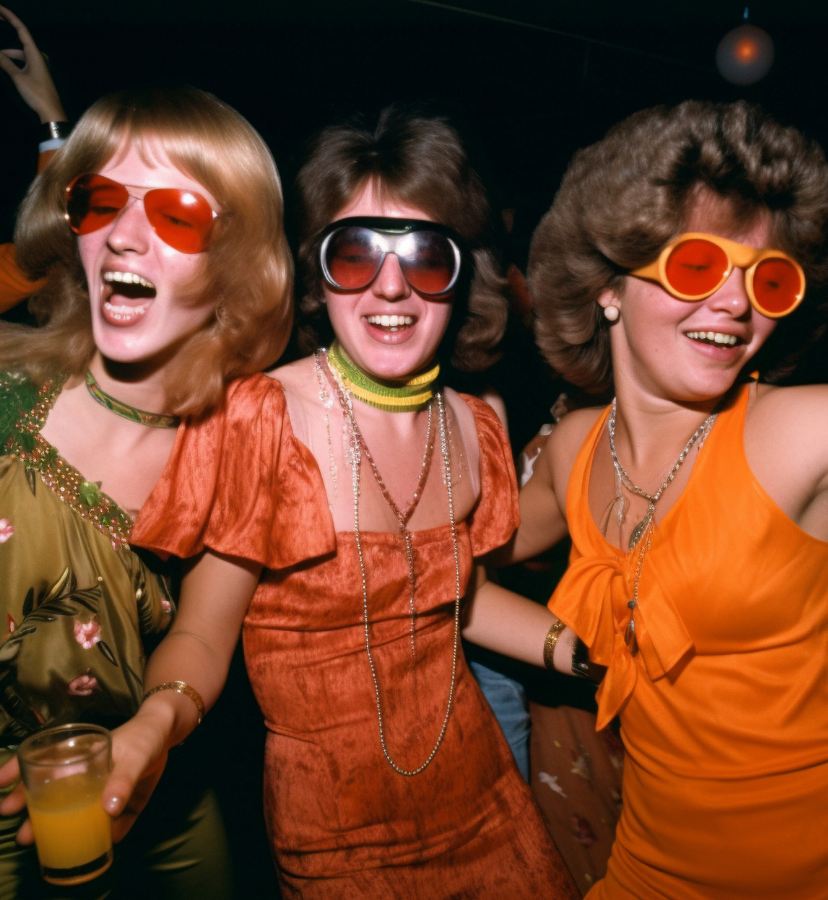
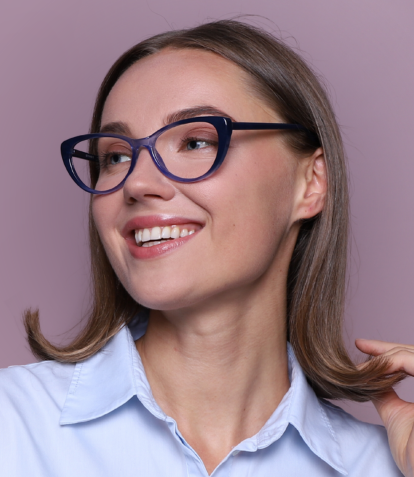
When Were Cat-Eye Glasses Popular?
You know the look. They’re unmistakable. Cat-eye glasses are the feminine frames with the feline form. Their signature upsweep sets them apart from other shapes, and in their almost 100-year history, cat-eye glasses’ popularity has been on a bit of a roller coaster ride. They’ve also got one of the most interesting backstories of any eyewear design, which is all befitting of an eyewear icon.
A revolutionary eyewear design
With the myriad of styles available today, it’s hard to imagine that glasses manufacturers didn’t always take aesthetics into consideration when crafting eyewear. For a long time, glasses served simply as a visual aid, with little variation in frame shapes, and no styles that were designed specifically for women.
This is the thought that occurred to Altina Schinasi, a window dresser from New York, one day in the 1930s. As she passed by an optician’s window, she noted that none of the frames on display had any hint of femininity about them. Seeing a gap in the market, she set herself the mission of creating a design with an air of whimsy, mystery and romance, that would cater to female wearers.
“What could a woman wear on her face that would be romantic?” she asked herself, triggering memories of her time spent in Venice and the elaborate Harlequin masks she had seen there. She used this shape as the basis of her new glasses design, and – after several rejections from the major manufacturers of the time for being too edgy – set up her own production.
Her Harlequin frames, as they became known, characterised by their prominent endpieces, were a revolution in glasses design, transforming an optical instrument into a fashion accessory.
The 1940s: their first full decade
In the 1940s, things really started to take off for the Harlequin frame. Schinasi moved her operation from New York to California and then sold the business after a few years. Even without her involvement, the design continued to grow in popularity. In this era, the frames were often glamorised further by adding metallic or coloured elements to the upswept corners.
This extra detailing was a hit; cat-eye glasses gradually became a more frequent sight among the general population, injecting a breath of fresh air into the eyewear industry. Still, even more widespread success was around the corner.
The 1950s: icon status achieved
Already becoming more commonplace by the start of the decade, cat-eye glasses really became a cultural phenomenon in the 1950s. Post-war optimism and the growing momentum of the feminist movement helped their case, but the biggest factor was probably their adoption by Hollywood royalty.
Thanks to this, cat-eye frames became the preferred choice for women all across America, with a more slender version accentuating the signature upsweep. The image of cat eye-glasses paired with a beehive hairdo has become an enduring image of the time, encapsulating the style of a generation.
The 1960s: Hollywood and haute couture
Another major boost for cat-eye glasses came at the beginning of the 1960s, when they appeared on the silver screen, worn by the female protagonists of some of the biggest films of the decade. This exposure really secured their place in pop culture – and the public consciousness – as a chic accessory that portrayed a strong female identity.
A trend for oversized cat-eye frames started to creep in during this time, replacing the slimmer design of years gone by. After 30-odd years at the top of the eyewear charts, however, they were about to be faced with some competition.
Emergence of competition and changing perceptions
A lot happened in the 1960s, and with the advent of the civil rights and hippie movements, fashion underwent its fair share of changes. With the rejection of the more conservative, stuffy values and style of the 50s, cat-eye glasses’ popularity began to wane, as other styles took over.
Round metal frames and oversized pilot shapes were the dominant looks as the 70s came into view. Cat-eye glasses changed with the times, which dictated that they, too, would need to be scaled up in size. Larger silhouettes meant the upsweep was less dramatic, and many cat-eye models deviated slightly from their original exaggerated shape to conform to the oversized look.
Even with these more modern takes on the design, other frame styles surpassed them in popularity, with the resurgence of the Ray-Ban Aviator and similar pilot-style glasses, in particular, taking a lot of the spotlight in the 1980s. It was the turn of slim metal frames, oval shapes and rimless designs in the 1990s and 2000s.
By this time, cat-eye glasses had fallen considerably far down the popularity charts. Of course, they were still around, but they weren’t enjoying the same widespread appreciation of earlier years. Their association with the 1950s remained strong, but tastes had evolved a lot since then. Cat-eye glasses were now largely perceived as a relic of the past, a style that the youth of that era had held on to, a generation that was now of more mature age.
The 2010s and 2020s: the comeback
We all know that nothing lasts forever, so a dip in popularity for the cat-eye frame shape was bound to happen at some stage. Then again, fashion is cyclical. Despite being seen as somewhat uncool for the previous few decades, cat-eye glasses began making their steady comeback in the latter half of the 2010s.
Replacing the movie stars of the 1950s, today’s models and influencers have helped cat-eye frames rediscover their glamorous appeal, with social media playing a major role in the whole process. Cat-eye sunglasses in particular have enjoyed a revival, with prints and patterned looks applied to many models. The variety on offer today encompasses all of the shape variations seen over the years, plus some more contemporary options, and plenty of men’s versions now also available.
Cat-eye glasses have firmly re-established themselves in the style and popularity stakes, and it looks like they’re going to stick around for the foreseeable future. Looking at some of the amazing designs out there, it’s a wonder that the cat-eye shape ever lost its allure – even if it was just temporary – in the first place.
When Were Cat-Eye Glasses Popular?
You know the look. They’re unmistakable. Cat-eye glasses are the feminine frames with the feline form.
Their signature upsweep sets them apart from other shapes, and in their almost 100-year history, cat-eye glasses’ popularity has been on a bit of a roller coaster ride.
They’ve also got one of the most interesting backstories of any eyewear design, which is all befitting of an eyewear icon.
A revolutionary
eyewear design
With the myriad of styles available today, it’s hard to imagine that glasses manufacturers didn’t always take aesthetics into consideration when crafting eyewear.
For a long time, glasses served simply as a visual aid, with little variation in frame shapes, and no styles that were designed specifically for women.
This is the thought that occurred to Altina Schinasi, a window dresser from New York, one day in the 1930s. As she passed by an optician’s window, she noted that none of the frames on display had any hint of femininity about them.
Seeing a gap in the market, she set herself the mission of creating a design with an air of whimsy, mystery, and romance, that would cater to female wearers.
“What could a woman wear on her face that would be romantic?” she asked herself, triggering memories of her time spent in Venice and the elaborate Harlequin masks she had seen there.
She used this shape as the basis of her new glasses design, and – after several rejections from the major manufacturers of the time for being too edgy – set up her own production.
Her Harlequin frames, as they became known, characterised by their prominent endpieces, were a revolution in glasses design, transforming an optical instrument into a fashion accessory.
The 1940s: their first full decade
In the 1940s, things really started to take off for the Harlequin frame. Schinasi moved her operation from New York to California and then sold the business after a few years.
Even without her involvement, the design continued to grow in popularity. In this era, the frames were often glamorised further by adding metallic or coloured elements to the upswept corners.
This extra detailing was a hit; cat-eye glasses gradually became a more frequent sight among the general population, injecting a breath of fresh air into the eyewear industry. Still, even more widespread success was around the corner.
The 1950s: icon status achieved
Already becoming more commonplace by the start of the decade, cat-eye glasses really became a cultural phenomenon in the 1950s.
Post-war optimism and the growing momentum of the feminist movement helped their case, but the biggest factor was probably their adoption by Hollywood royalty.
Thanks to this, cat-eye frames became the preferred choice for women all across America, with a more slender version accentuating the signature upsweep.
The image of cat eye-glasses paired with a beehive hairdo has become an enduring image of the time, encapsulating the style of a generation.
The 1960s: Hollywood and haute couture
Another major boost for cat-eye glasses came at the beginning of the 1960s, when they appeared on the silver screen, worn by the female protagonists of some of the biggest films of the decade.
This exposure really secured their place in pop culture – and the public consciousness – as a chic accessory that portrayed a strong female identity.
A trend for oversized cat-eye frames started to creep in during this time, replacing the slimmer design of years gone by.
After 30-odd years at the top of the eyewear charts, however, they were about to be faced with some competition.
Emergence of competition and changing perceptions
A lot happened in the 1960s, and with the advent of the civil rights and hippie movements, fashion underwent its fair share of changes.
Rejecting the more conservative, stuffy values and style of the 50s, cat-eye glasses’ popularity began to wane as a result, as other styles took over.
Round metal frames and oversized pilot shapes were the dominant looks as the 70s came into view.
Cat-eye glasses changed with the times, which dictated that they, too, would need to be scaled up in size.
Larger silhouettes meant the upsweep was less dramatic, and many cat-eye models deviated slightly from their original exaggerated shape to conform to the oversized look.
Even with these more modern takes on the design, other frame styles surpassed them in popularity, with the resurgence of the Ray-Ban Aviator and similar pilot-style glasses, in particular, taking a lot of the spotlight in the 1980s.
It was the turn of slim metal frames, oval shapes and rimless designs in the 1990s and 2000s.
By this time, cat-eye glasses had fallen considerably far down the popularity charts.
Of course, they were still around, but they weren’t enjoying the same widespread appreciation of earlier years. Their association with the 1950s remained strong, but tastes had evolved a lot since then.
Cat-eye glasses were now largely perceived as a relic of the past, a style that the youth of that era had held on to, a generation that was now of more mature age.
The 2010s and 2020s: the comeback
We all know that nothing lasts forever, so a dip in popularity for the cat-eye frame shape was bound to happen at some stage. Then again, fashion is cyclical.
Despite being seen as somewhat uncool for the previous few decades, cat-eye glasses began making their steady comeback in the latter half of the 2010s.
Replacing the movie stars of the 1950s, today’s models and influencers have helped cat-eye frames rediscover their glamorous appeal, with social media playing a major role in the whole process.
Cat-eye sunglasses in particular have enjoyed a revival, with prints and patterned looks applied to many models.
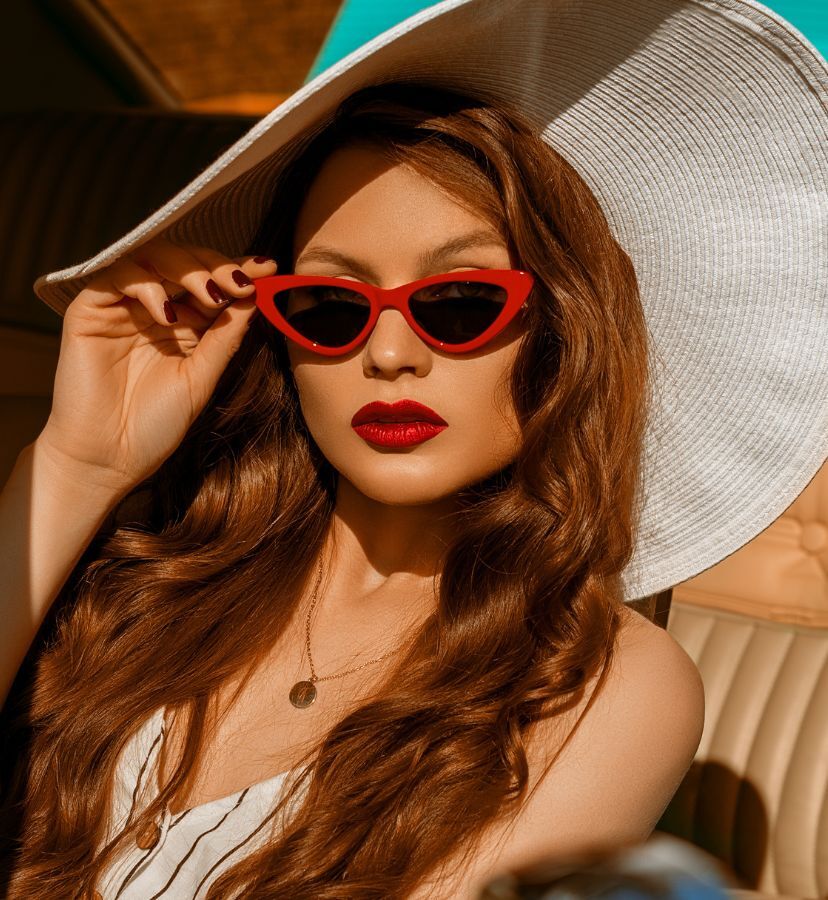
The variety on offer today encompasses all of the shape variations seen over the years, plus some more contemporary options, and plenty of men’s versions now also available.
Cat-eye glasses have firmly re-established themselves in the style and popularity stakes, and it looks like they’re going to stick around for the foreseeable future.
Looking at some of the amazing designs out there, it’s a wonder that the cat-eye shape ever lost its allure – even if it was just temporary – in the first place.





































